In the heart of the world's largest democracy, a silent war is being waged against religious minorities. Under the watch of Prime Minister Narendra Modi's Bharatiya Janata Party (BJP), India has witnessed an unprecedented rise in Hindu extremism that has transformed from fringe ideology to state policy. What was once condemned as terrorism when committed by others is now celebrated as patriotism when directed against Muslims, Christians, and other minority communities. This systematic campaign of hate, discrimination, and violence bears chilling parallels to other dark chapters of history, including the ongoing persecution of Palestinians by Israeli forces—a comparison that grows more disturbing with each passing day.
The transformation of India from a secular democracy to a Hindu Extremist state has been neither accidental nor spontaneous. It is the result of a carefully orchestrated campaign that began long before the BJP came to power in 2014 but has accelerated dramatically under their rule. Today, Hindu extremism operates with near impunity, protected by a political establishment that not only refuses to condemn it but actively encourages it. From the highest levels of government to the streets of small towns, a toxic combination of religious hatred, political opportunism, and state power has created a perfect storm for persecution.
What makes this situation particularly alarming is how openly it is being carried out. BJP leaders regularly make inflammatory speeches against minorities, knowing there will be no consequences. Police stand by as mobs attack Muslim neighborhoods. Courts approve the demolition of homes belonging to accused rioters before any trial takes place. And through it all, a significant portion of the Hindu majority either remains silent or actively supports these actions, convinced that they are necessary to "protect" their religion and culture.
This article exposes the systematic campaign of Hindu extremism in India, drawing parallels with the Israeli-Palestinian conflict to highlight the dangerous trajectory of a nation once celebrated for its diversity and secular values. It examines how the BJP has weaponized religion for political gain, how state institutions have been co-opted to serve majoritarian interests, and how ordinary Muslims have become targets in a war they never chose to fight. It also explores the new frontier of this hate campaign: the use of artificial intelligence to create and spread anti-Muslim content at an unprecedented scale.
Historical Context: From Secular Foundations to Majoritarian Shift
To understand the current crisis, we must look back at India's founding principles and how they have been systematically eroded. When India gained independence in 1947, its leaders consciously chose to be a secular republic, rejecting the two-nation theory that led to the creation of Pakistan. The Indian Constitution, adopted in 1950, guaranteed freedom of religion to all citizens and established a framework for a pluralistic democracy where people of all faiths could coexist peacefully.
For decades, this secular framework held, despite occasional communal tensions. The Indian National Congress, which dominated politics for much of the post-independence period, maintained a commitment to secularism, even if imperfectly implemented. Minority communities, particularly Muslims who had chosen to remain in India rather than migrate to Pakistan, were integrated into the national fabric and made significant contributions to all aspects of Indian society.
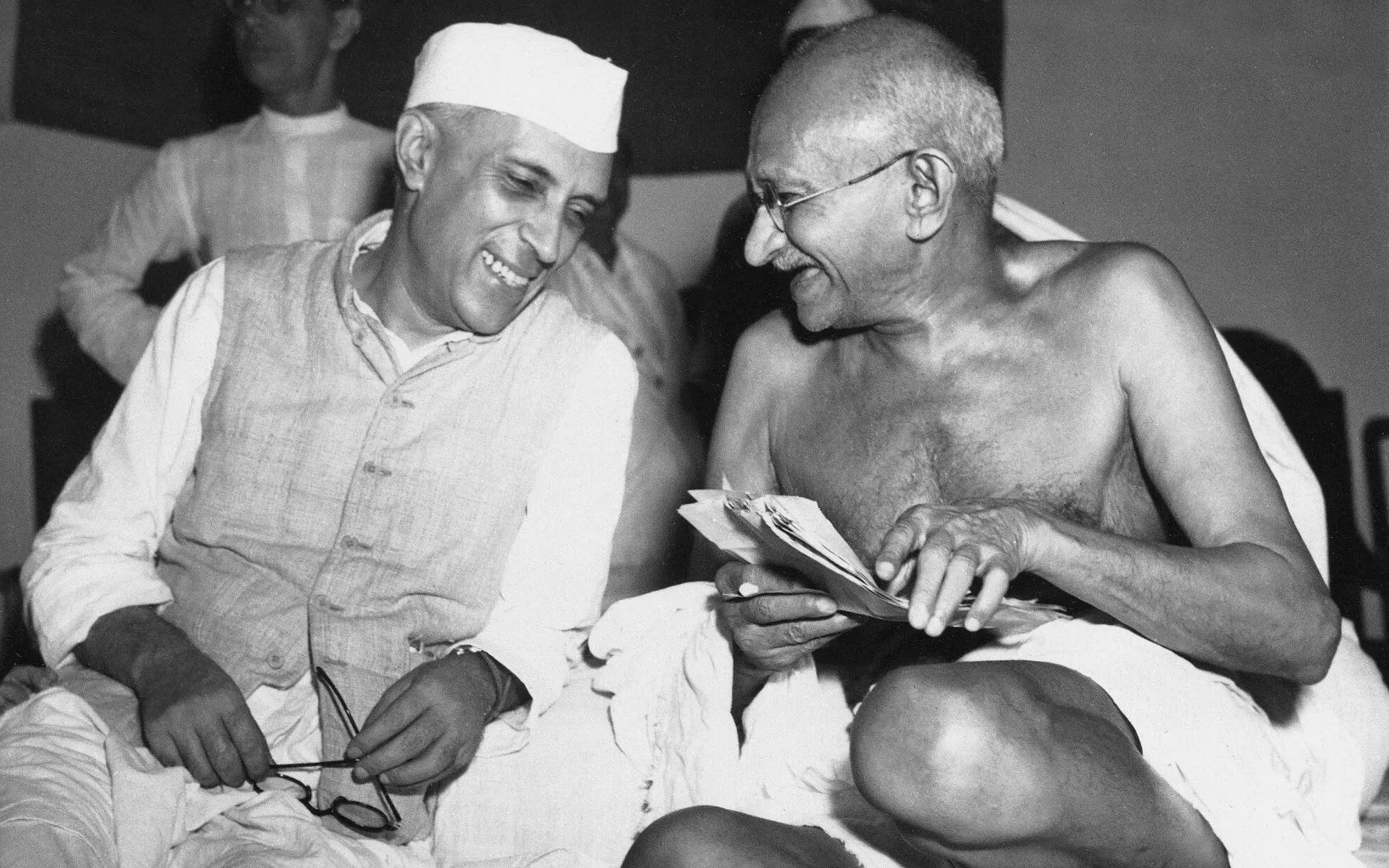
India's founding leaders, including Mahatma Gandhi and Jawaharlal Nehru, envisioned a secular nation where all religions could flourish. Source: Historical Archives
The seeds of Hindu nationalism were planted during this period but remained largely on the fringes. Organizations like the Rashtriya Swayamsevak Sangh (RSS), the ideological parent of the BJP, promoted the idea of India as fundamentally a Hindu nation. They viewed secularism as a concession to minorities and believed that India's true identity had been suppressed by centuries of Muslim rule and British colonialism. However, their influence was limited in the early decades after independence.
Turning point came in the 1980s and 1990s, when the BJP and its allies began to mobilize Hindu sentiment around the Babri Masjid dispute in Ayodhya. The campaign to build a Ram temple at the site of the mosque, which Hindus believed to be the birthplace of Lord Ram, became a rallying point for Hindu nationalism. The demolition of the Babri Masjid in 1992 by Hindu mobs marked a significant shift in Indian politics, demonstrating the power of religious mobilization and setting the stage for the BJP's rise.
Even then, the BJP had to moderate its stance to gain power at the national level. When Atal Bihari Vajpayee led BJP-led coalition governments between 1998 and 2004, the party had to work with secular allies and could not openly pursue its Hindu nationalist agenda. However, the period laid the groundwork for what was to come, building networks of supporters and normalizing Hindu nationalist rhetoric in public discourse.
Election of Narendra Modi as Prime Minister in 2014 marked the beginning of a new era. Modi, who had been Chief Minister of Gujarat during the 2002 riots that killed over 1,000 people, mostly Muslims, brought a more aggressive form of Hindu nationalism to the center of Indian politics. His victory was followed by a series of developments that systematically undermined India's secular fabric:
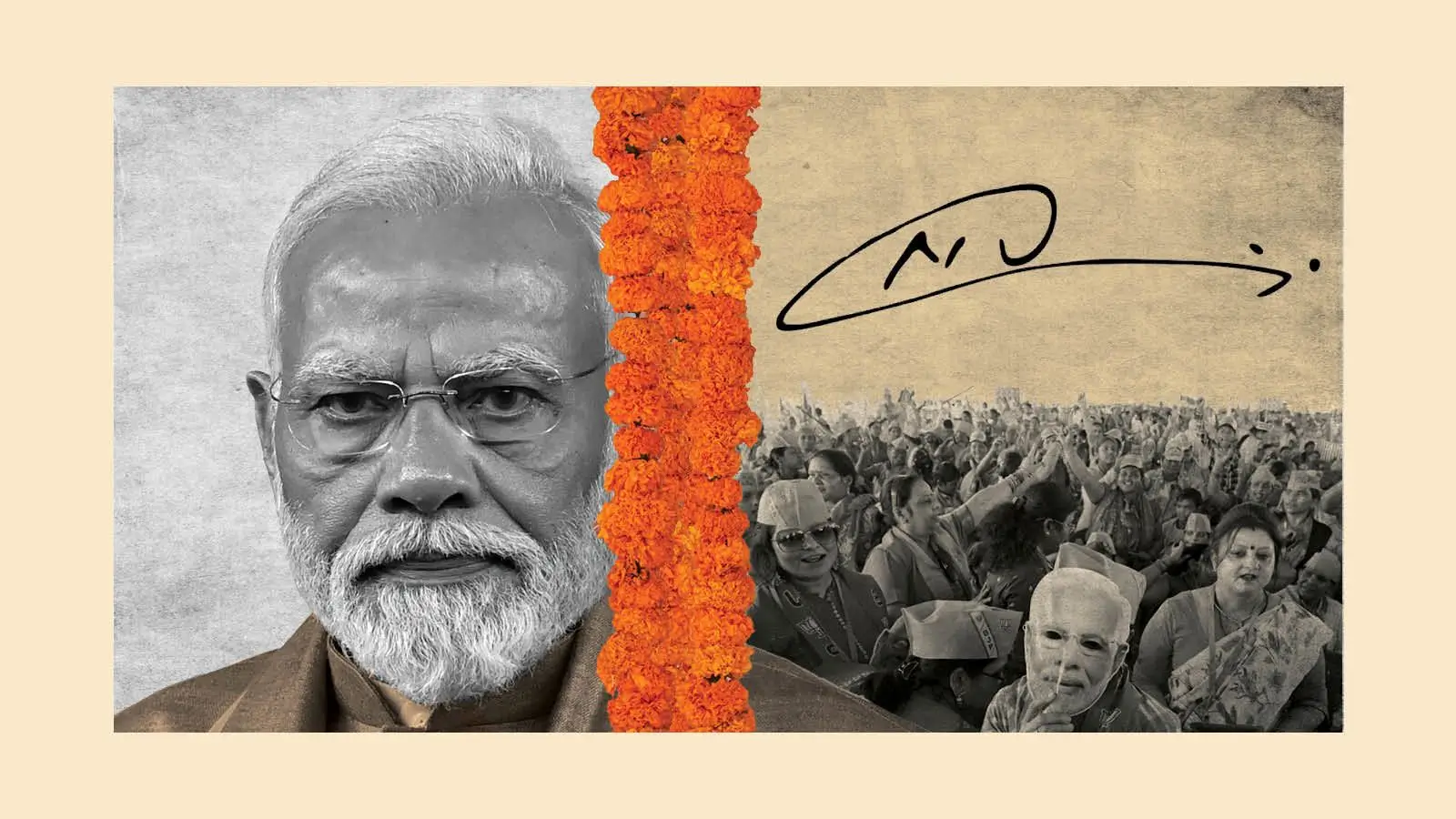
Since Narendra Modi's rise to power in 2014, there has been an increase in terrorist mentality among Hindus. (Source: CNN)
- The appointment of hardline Hindu nationalists to key positions in government, education, and cultural institutions
- The rewriting of school textbooks to emphasize Hindu contributions to Indian civilization while downplaying Muslim rulers
- The introduction of laws that discriminated against Muslims, such as the Citizenship Amendment Act (CAA) that fast-tracked citizenship for non-Muslim refugees from neighboring countries
- The revocation of Article 370, which granted special autonomy to Muslim-majority Jammu and Kashmir
- The increasing use of bulldozers to demolish properties belonging to Muslims, often without due process
- The growing impunity for those who commit violence against Muslims, with few prosecutions and even fewer convictions
These developments did not happen in isolation. They were part of a broader project to transform India from a secular democracy to a Hindu state. The pace of this transformation has accelerated in recent years, with Hindu extremism becoming more open, more violent, and more accepted by mainstream society.
Bulldozer Justice: The Demolition of Muslim Lives and Properties
One of the most visible and brutal manifestations of Hindu extremism in India today is the use of bulldozers to demolish homes and businesses belonging to Muslims. This practice, euphemistically called "bulldozer justice," has become a common tool of state oppression against minority communities. What makes it particularly chilling is how openly it is carried out, often with media coverage and public celebrations by Hindu nationalist leaders.
The pattern is consistent across states: after an incident of communal violence or even an accusation against a Muslim, authorities quickly move to demolish their property, claiming it is illegal construction. In most cases, no notice is given, no opportunity is provided to challenge the action, and no due process is followed. The message is clear: Muslims are not entitled to the same legal protections as Hindus, and their property can be destroyed at will.
The practice gained national attention in April 2022 during communal violence in Khargone, Madhya Pradesh. After clashes between Hindus and Muslims left several people injured, the state government, led by the BJP, demolished the homes and shops of several Muslims accused of involvement in the violence. The demolitions were carried out without any legal process, and the owners were not given any opportunity to defend themselves.
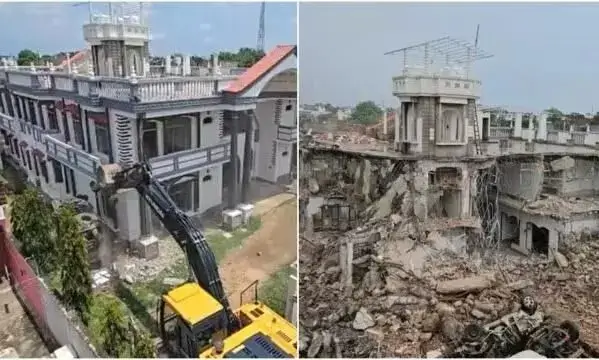
Bulldozers indiscriminately bulldoze Muslim properties in Khargone, Madhya Pradesh, in April 2022, without any justification. Source: NYT
What was particularly disturbing about the Khargone demolitions was how they were celebrated by BJP leaders. Madhya Pradesh Chief Minister Shivraj Singh Chouhan openly endorsed the action, stating that those who "burn others' houses will have their houses demolished." Other BJP leaders went further, with a party official in Uttarakhand warning that those who "spread chaos" would meet the same fate. These statements made it clear that the demolitions were not about enforcing building codes but about punishing Muslims for their alleged involvement in communal violence.
Since then, bulldozer justice has been used repeatedly across BJP-ruled states. In Delhi, following communal violence in Jahangirpuri in 2022, the municipal corporation demolished several shops and structures, many belonging to Muslims, despite a Supreme Court order staying the demolitions. In Uttar Pradesh, Chief Minister Yogi Adityanath has frequently threatened to use bulldozers against "criminals," a term often used to refer to Muslims. In Assam, the state government has demolished homes of those accused of illegal immigration, most of whom are Muslims.
The parallels with Israeli actions in Palestinian territories are striking and disturbing. Just as Israel uses home demolitions as a collective punishment against Palestinians, Indian authorities are using similar tactics against Muslims. Both practices violate international law and basic principles of justice. Both target vulnerable communities with little recourse to legal protection. And both are designed to send a message of intimidation and subjugation.

(Left: India / Right: Israel) In the West Bank, Israeli forces demolish Palestinian homes a practice very similar to the bulldozer demolitions against Muslims in India
Impact of these demolitions extends far beyond the loss of property. For Muslims in India, the sight of bulldozers destroying their homes has become a symbol of their second-class status in their own country. It reinforces the message that they are not welcome, that they are perpetual outsiders, and that the state will not protect them. This psychological trauma, combined with the economic devastation of losing one's home or business, has created a climate of fear and hopelessness among many Muslim communities.
What makes this situation even more alarming is the public celebration of these actions. Videos of demolitions often go viral on social media, accompanied by comments praising the authorities and calling for more such actions. BJP leaders and supporters share these videos as evidence of their government's "strong" stance against "anti-national elements." This public celebration of state violence against a minority community is a dangerous sign of how far India has strayed from its democratic values.
Bulldozer has become more than just a machine for demolition; it has evolved into a symbol of state power used selectively against minorities. When the state itself becomes the perpetrator of violence against its own citizens, the line between democracy and authoritarianism begins to blur.
BJP Leaders Leading the Hate Campaign againt Muslim
Perhaps the most disturbing aspect of Hindu extremism in India is how openly political leaders, particularly from the BJP, incite hatred against minorities. In a functioning democracy, such leaders would be held accountable for their words and actions. In India today, they are often rewarded with electoral victories and promotions within the party hierarchy.
Pattern of incitement follows a familiar script. A BJP leader makes an inflammatory speech targeting Muslims, often using dehumanizing language and false accusations. The speech is widely shared on social media and amplified by right-wing media outlets. Minor protests may follow, but no serious action is taken against the leader. In some cases, the leader is even defended by senior party officials, who claim their words were taken out of context or that they were merely expressing the sentiments of the people.
One of the most egregious examples of this incitement came from Kapil Mishra, a BJP leader in Delhi, just before the communal violence in February 2020. At a pro-CAA rally, Mishra openly threatened anti-CAA protesters, most of whom were Muslims, stating that police would not intervene if they took matters into their own hands. "I am giving the police three days' time to clear the roads... After that, don't come to us asking for help," he said, adding that he would personally lead the "action." Within hours of his speech, violence erupted in Northeast Delhi, leaving over 50 people dead, most of them Muslims.
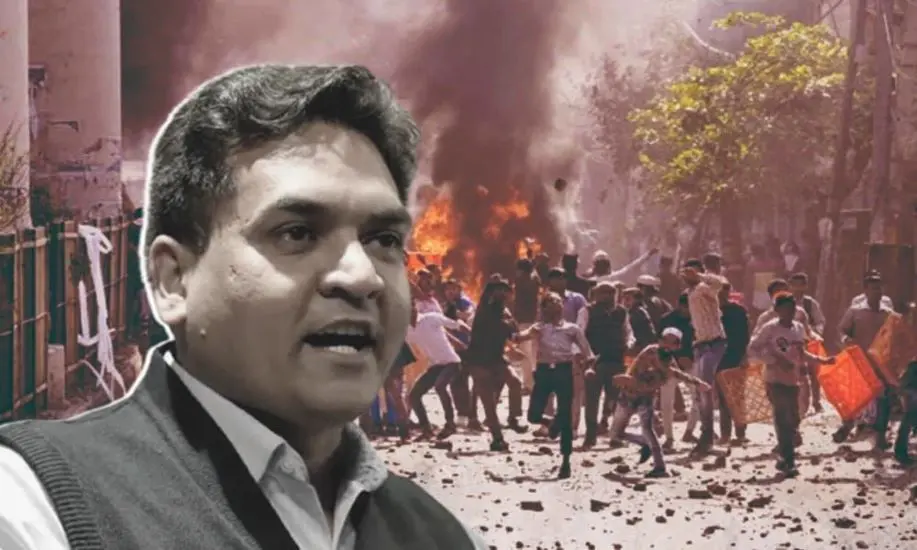
BJP Leader Kapil Mishra Incites Communal Violence with Hate Speech Against Muslims in Delhi February 2020. (Source: NYT)
Despite clear evidence that his speech incited violence, Mishra faced no serious consequences. The police initially refused to register an FIR against him, and when they finally did, it was only after immense public pressure. Even then, the investigation proceeded slowly, and Mishra continued to make inflammatory statements without fear of reprisal. He was eventually expelled from the BJP in 2021, not for his role in the violence but for criticizing the party leadership.
Mishra is far from the only BJP leader to engage in such incitement. Anurag Thakur, now a Union Minister, led chants of "Desh ke gaddaron ko, goli maaro saalon ko" (Shoot the traitors of the country) at a campaign rally just before the Delhi violence. Giriraj Singh, another Union Minister, has repeatedly made anti-Muslim statements, including suggesting that those opposing the CAA should go to Pakistan. Yogi Adityanath, Chief Minister of Uttar Pradesh, has referred to protesters as "anti-national elements" and threatened to take "revenge" against them.
What makes these statements particularly dangerous is that they come from elected officials who have taken an oath to uphold the Constitution, which guarantees equality to all citizens regardless of religion. When leaders openly target a particular community, they send a message that discrimination and violence against that community are acceptable. This message is heard not only by their supporters but also by law enforcement agencies, which become less likely to protect the targeted community and more likely to act against them.
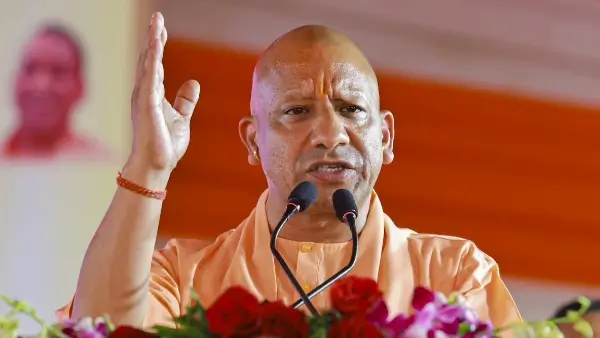
Uttar Pradesh Chief Minister Yogi Adityanath has a history of making inflammatory statements against Muslims. Source: India Today
Impact of this political incitement can be seen in the increasing number of hate crimes against Muslims across India. According to data compiled by various civil society organizations, there has been a significant rise in communal violence since the BJP came to power in 2014. What is particularly concerning is the nature of this violence – it is becoming more brutal, more organized, and more deadly.
In June 2022, a Muslim tailor named Kanhaiya Lal was brutally murdered in Udaipur, Rajasthan, by two men who filmed themselves killing him and posted the video online, claiming they were avenging an insult to Islam. In August 2022, a Muslim man was beaten to death in Jharkhand for allegedly transporting beef. In December 2022, a Muslim truck driver was lynched in Bihar on suspicion of smuggling cattle. These are not isolated incidents but part of a broader pattern of violence fueled by political incitement.
International community has taken note of this deterioration. The United States Commission on International Religious Freedom (USCIRF) has recommended that India be designated as a "Country of Particular Concern" for engaging in and tolerating systematic, ongoing, and egregious religious freedom violations. The European Parliament has passed resolutions condemning the Citizenship Amendment Act and the revocation of Article 370 in Kashmir. However, the Indian government has dismissed these concerns as interference in its internal affairs.
Mob Violence: When Lynchings Become State-Sanctioned Terror
Perhaps the most brutal manifestation of Hindu extremism in India is the rise in mob lynchings, particularly those targeting Muslims accused of killing cows or transporting beef. Since the BJP came to power in 2014, there has been a dramatic increase in such incidents, with mobs taking the law into their own hands, often with the tacit approval of local authorities and politicians.
Cow protection has historically been a sensitive issue in India, as Hindus consider cows sacred. However, the use of violence to "protect" cows is a relatively recent phenomenon, fueled by Hindu nationalist groups that have weaponized the issue to target Muslims. These groups, often calling themselves "cow vigilantes," patrol highways and rural areas, stopping vehicles they suspect of transporting cattle and attacking those inside, most of whom are Muslims.
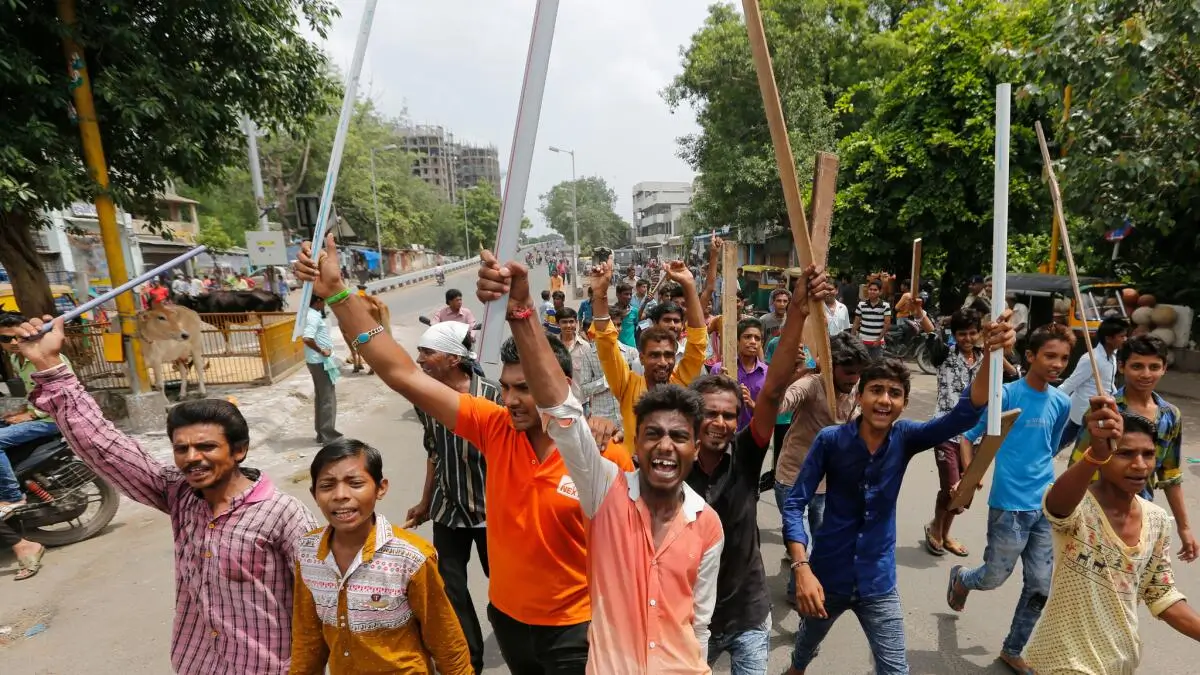
Cow vigilantes have become increasingly violent in their attacks on Muslims on the name of Cow God. Source: Los Angeles Times
One of the most shocking cases occurred in 2017, when Pehlu Khan, a 55-year-old Muslim dairy farmer from Rajasthan, was beaten to death by a mob of cow vigilantes in Alwar, Rajasthan. Khan was transporting cattle he had legally purchased at a cattle fair when his vehicle was stopped by the vigilantes. Despite showing them the purchase documents, he and his sons were brutally beaten. Khan died from his injuries two days later.
What made this case particularly egregious was that the police initially registered a case against Khan and his sons for allegedly transporting cattle illegally, while the vigilantes who killed him were allowed to go free. It was only after national outrage that the police finally registered a case against the attackers. Even then, the investigation proceeded slowly, and all six accused were eventually acquitted by a court in 2019, citing insufficient evidence.
Pehlu Khan case is not an isolated incident but part of a broader pattern of impunity for those who commit violence against Muslims in the name of cow protection. According to a report by Human Rights Watch, at least 44 people were killed by cow vigilantes between May 2015 and December 2018. Most of the victims were Muslims, and in many cases, the attackers were known to local authorities but were not arrested or prosecuted.
Rising hate and fake propaganda against Muslims to target them
Statistics show a shocking rise in hate crimes against minorities since 2014:
Role of social media in facilitating these attacks cannot be overstated. Platforms like WhatsApp and Facebook have been used to spread rumors and false accusations against Muslims, often leading to violence. In 2018, rumors of child kidnappers spread on WhatsApp led to the lynching of several innocent people across India, including Muslims. Despite being alerted to the problem, social media companies were slow to respond, and the government did little to regulate these platforms until public pressure mounted.
What makes these lynchings particularly terrifying is the public nature of the violence. Videos of the attacks are often filmed by the perpetrators themselves and shared on social media, where they go viral and are celebrated by Hindu nationalist groups. The attackers are often seen posing with their victims, as if they have accomplished something heroic. This public celebration of violence creates a climate of fear and intimidation, sending a clear message to Muslims that they are not safe anywhere in India.
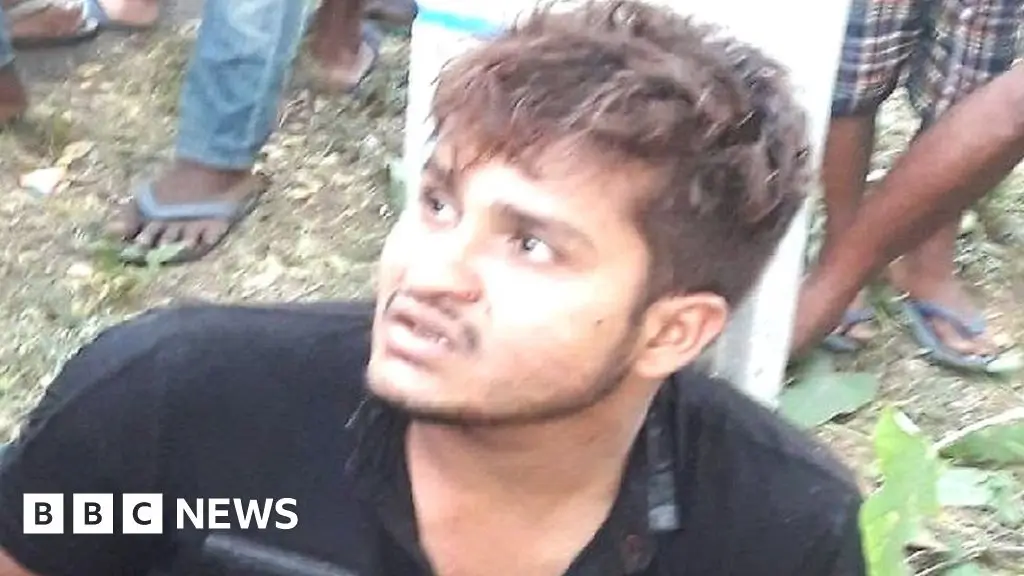
In Jharkhand, Muslim man Tabrez Ansari was brutally killed by Hindu terrorists. Sadly, such attacks are now happening more Common across India. Source: BBC
The response of the BJP government to these lynchings has been deeply concerning. Instead of condemning the violence unequivocally, BJP leaders have often made statements that appear to justify or minimize it. Prime Minister Modi has spoken against mob lynchings, but his words have not been matched by action. In many cases, the police have been slow to respond to attacks, and when they do, they often treat the victims as suspects rather than the perpetrators.
This state-sanctioned terror has had a devastating impact on Muslim communities across India. Many live in constant fear, knowing that a false accusation or a rumor on social media could lead to a violent attack. Some have changed their daily routines to avoid potential confrontations, while others have stopped working in professions that might make them targets, such as cattle trading or meat selling. The psychological toll of living under such constant threat is immeasurable.
When mob violence becomes normalized and even celebrated by political leaders, the line between democracy and mobocracy begins to blur. The failure of state institutions to protect minorities from such violence represents not just a failure of governance but a betrayal of the constitutional promise of equal protection under the law.
Legal Persecution: Weaponizing the Law Against Minorities
Beyond physical violence and property destruction, Hindu extremism in India has manifested in the systematic weaponization of the legal system against minorities. Laws that are ostensibly neutral in their language are applied selectively and discriminatorily, creating a two-tiered system of justice where Muslims are treated more harshly than Hindus.
Most egregious example of this legal persecution is the Citizenship Amendment Act (CAA) passed in 2019. The act fast-tracks Indian citizenship for non-Muslim refugees from Bangladesh, Pakistan, and Afghanistan who entered India before 2015. By explicitly excluding Muslims, the act violates the secular principles of the Indian Constitution and creates a religious test for citizenship that is unprecedented in India's history.
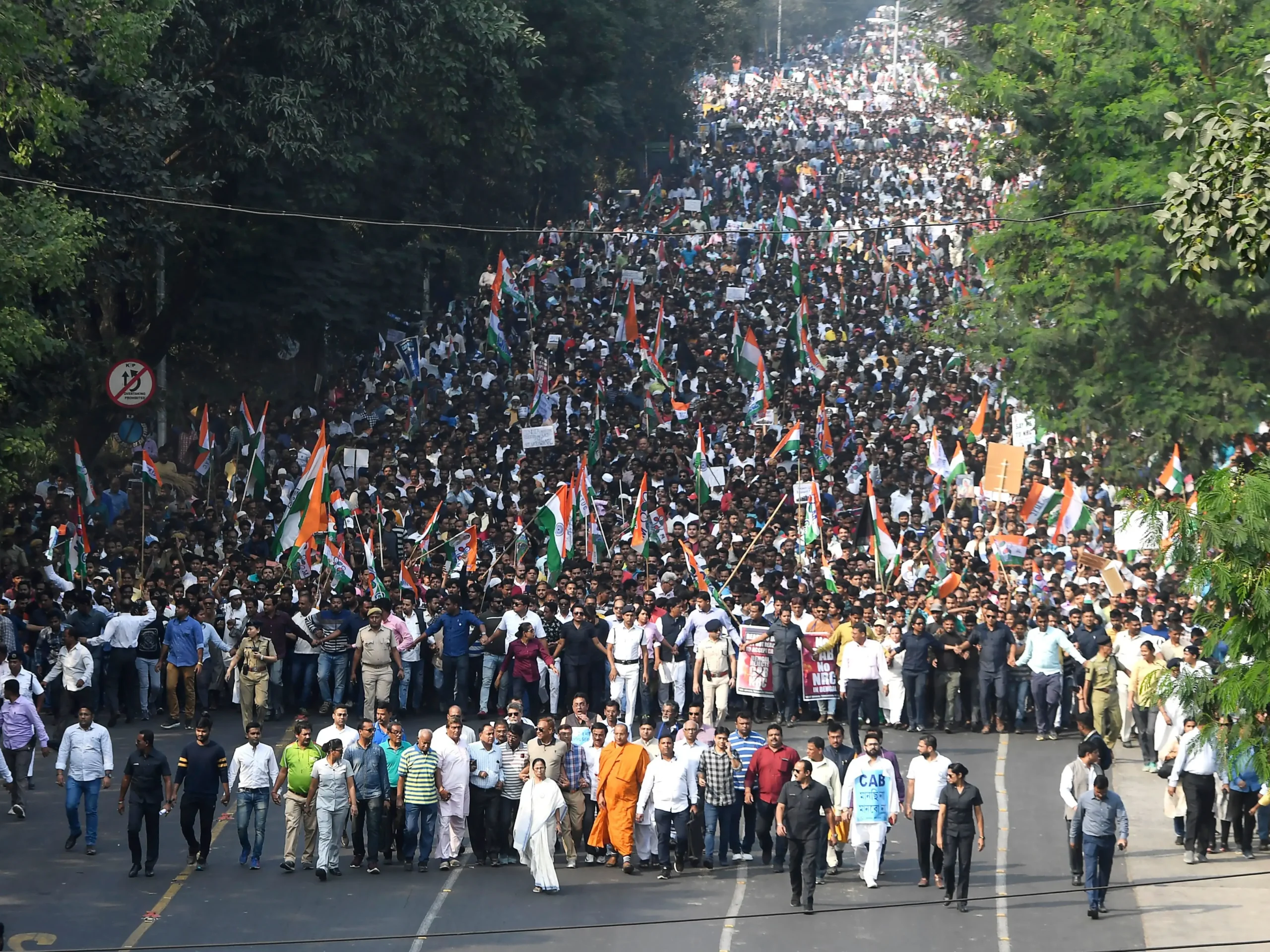
Peaceful protests broke out across India against the Citizenship Amendment Act, which critics say openly discriminates against Muslims. Source: WUNC
The CAA is particularly dangerous when combined with the proposed National Register of Citizens (NRC), which would require all Indians to prove their citizenship through documentation. Many Muslims, particularly those who are poor or illiterate, lack the necessary documents to prove their citizenship. Under the CAA, non-Muslims who cannot provide documentation would still be eligible for citizenship, while Muslims would be declared illegal immigrants and potentially stateless.
The implications of this combination are terrifying. It could lead to the largest statelessness crisis in the world, with millions of Muslims at risk of losing their citizenship and all associated rights. They could be denied access to education, healthcare, employment, and even the right to vote. In the worst-case scenario, they could be detained in camps or deported, creating a humanitarian crisis of unimaginable proportions.
Another example of legal persecution is the use of anti-terror laws against Muslims. The Unlawful Activities (Prevention) Act (UAPA), India's primary anti-terror law, has been used disproportionately against Muslims. According to data from the National Crime Records Bureau, Muslims make up a disproportionate percentage of those arrested under the UAPA, despite accounting for only about 14% of India's population.
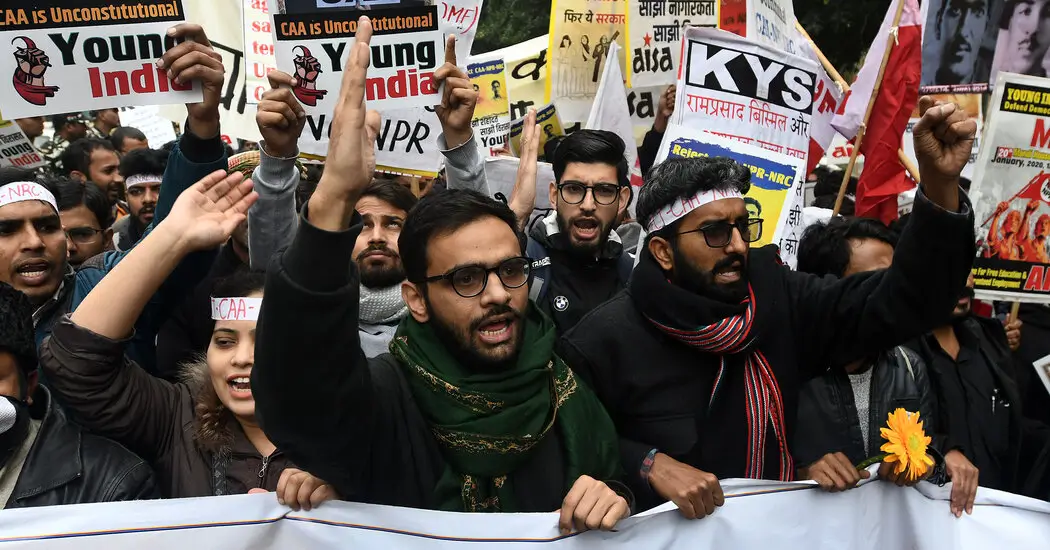
In India, Muslims are often detained under anti-terror laws for years without trial or any proof Source: NYT
What makes the UAPA particularly dangerous is its low conviction rate and stringent bail provisions. According to government data, between 2018 and 2020, only 2.2% of cases registered under the UAPA resulted in conviction. This means that the vast majority of those arrested under the act spend years in jail without trial, their lives and families destroyed, only to be acquitted eventually. The act has been criticized by human rights organizations for being used to silence dissent and target minorities.
The revocation of Article 370 in Jammu and Kashmir in 2019 is another example of legal persecution. Article 370 granted special autonomy to the Muslim-majority region, including its own constitution and flag. By revoking it, the BJP government stripped Kashmir of its special status and brought it fully under Indian law. The move was accompanied by a massive security crackdown, with thousands of political leaders, activists, and ordinary citizens detained without charge. Communication channels were cut off for months, and the region was effectively put under siege.
The impact of these legal measures on Muslim communities has been devastating. They have created a sense of insecurity and alienation, with many feeling that they are no longer equal citizens in their own country. The psychological toll of living under the constant threat of legal persecution is immeasurable, particularly for younger Muslims who see their future prospects diminishing.
AI-Generated Hate: The New Frontier of Islamophobia
As if the existing forms of persecution were not enough, Hindu extremists have now embraced artificial intelligence to create and spread hate against Muslims at an unprecedented scale. A groundbreaking report by the Center for the Study of Organized Hate (CSOH) has documented how generative AI tools are being deployed to produce and disseminate anti-Muslim visual content that is more sophisticated, more convincing, and more dangerous than anything seen before.
The CSOH report, titled "AI-Generated Imagery and the New Frontier of Islamophobia in India," analyzed 1,326 publicly available AI-generated images and videos retrieved from 297 public accounts across X (formerly Twitter), Facebook, and Instagram between May 2023 and May 2025. What they found was a systematic and coordinated effort to use AI-generated visuals to promote Islamophobic narratives that dehumanize, sexualize, criminalize, or incite violence against Muslims.
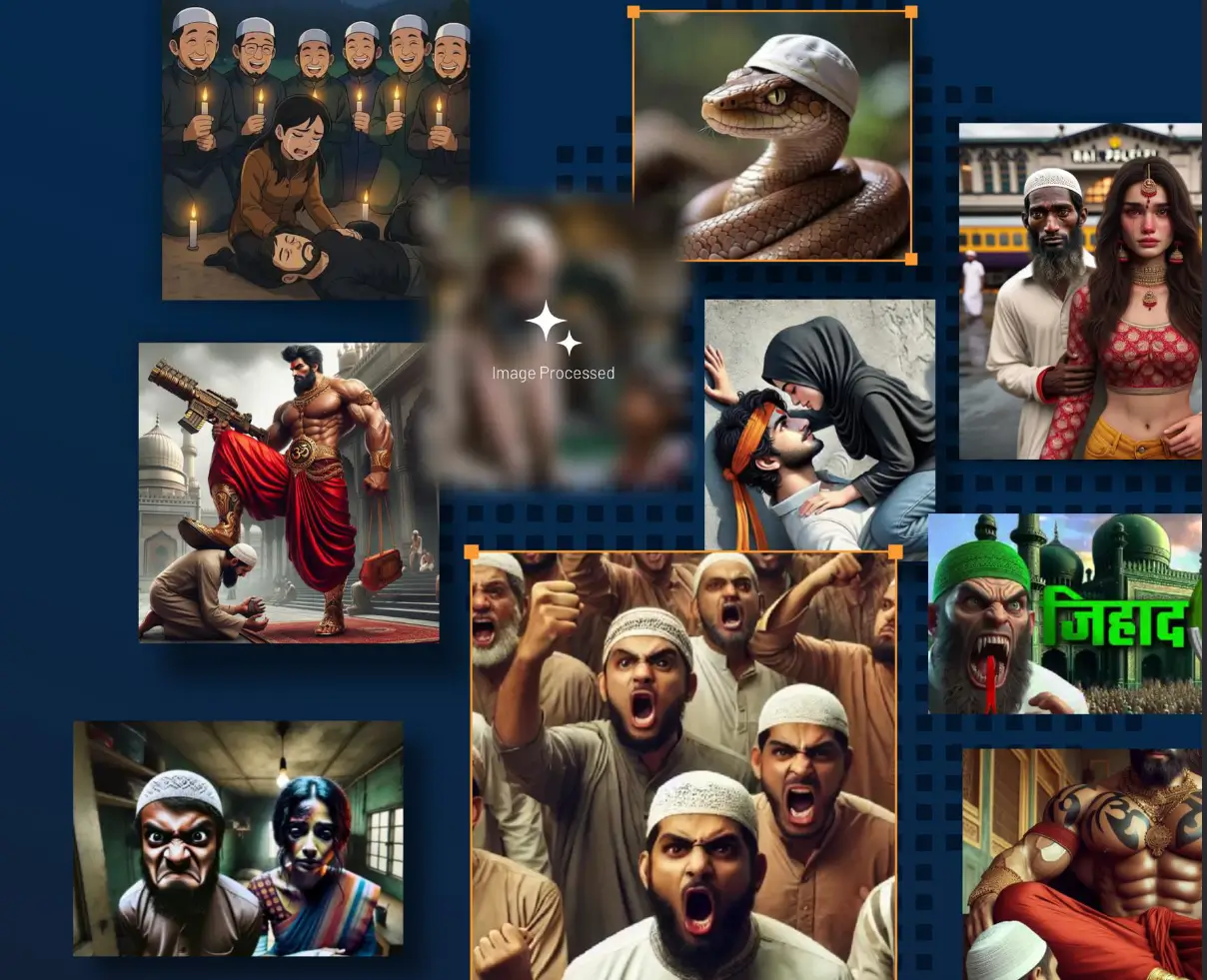
AI-generated images are now being used by Hindutva for spread hate against Muslims in India making fake stories look real and harder to catch Source: CSOH Report
Use of AI-generated content focused on spreading hate against Muslims spiked significantly after January 2024, coinciding with the wider adoption of AI tools in India. These images are particularly dangerous because they can be created quickly, customized to specific narratives, and distributed widely before platforms can develop effective detection and moderation strategies. Unlike conventional photographs or videos, which can often be verified through metadata or reverse image searches, AI-generated visuals present a unique challenge to fact-checkers and platform moderators.
The CSOH researchers identified four main categories of AI-generated hate content: the sexualization of Muslim women, exclusionary and dehumanizing rhetoric, conspiratorial narratives, and the aestheticization of violence. Each category serves a specific purpose in the broader campaign of hate against Muslims, reinforcing existing prejudices while introducing new elements that make the hate more palatable, humorous, or aesthetically appealing to broader audiences.
Four Categories of AI-Generated Hate
CSOH report identified four dominant themes in AI-generated anti-Muslim content:
Category of sexualized depictions of Muslim women received the highest engagement, with 6.7 million interactions across platforms. This reveals the gendered character of much Islamophobic propaganda, which fuses misogyny with anti-Muslim hate to create particularly potent forms of dehumanization. These images often depict Muslim women in sexualized scenarios, combining religious symbols like the burqa with sexual innuendos to objectify and dehumanize them.
Conspiratorial narratives, which received 6.0 million interactions, focus on promoting theories like 'Love Jihad,' 'Population Jihad,' and 'Rail Jihad' that frame Muslims as a perpetual threat to Hindu society and national security. These AI-generated images often depict Muslim men as menacing figures, particularly when dressed in Muslim-coded attire like skullcaps, juxtaposed with images of frightened or helpless Hindu women.
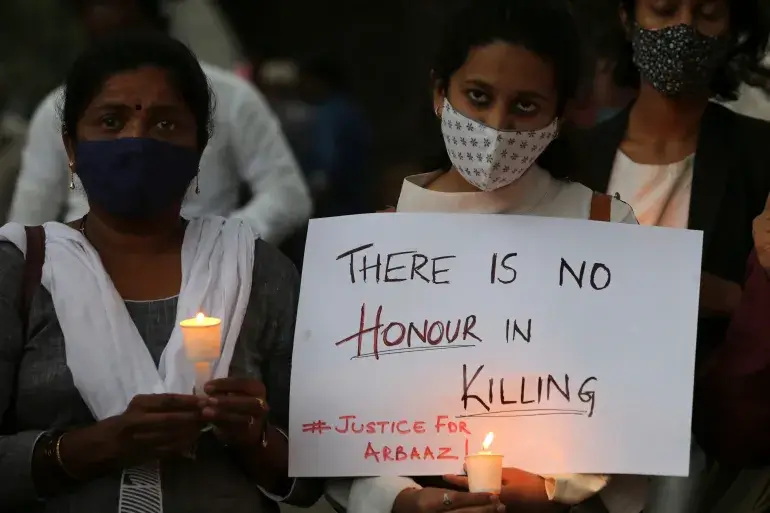
Arbaaz was killed by Hindu extremists in the false name of ‘love jihad,’ yet the government has taken no action against his killers. Source: The Guardian
Dehumanizing rhetoric, which received 6.4 million interactions, uses visual metaphors to portray Muslims as less than human. One particularly disturbing trend is the depiction of Muslims as snakes wearing skullcaps, a metaphor that frames them as deceptive, dangerous, and deserving of elimination. These images often show Muslims as aggressors, angry, armed, and engaged in various acts of destruction, feeding into a broader narrative of inherent Muslim criminality.
Aestheticization of violence, which received 6.0 million interactions, is perhaps the most insidious category. These images use stylized and animated AI aesthetics, including Studio Ghibli-style imagery, to make violent, hateful content appear palatable, even humorous, broadening its reach among younger audiences. By presenting hateful content in aesthetically pleasing or humorous formats, these images can bypass psychological defenses and make their messages more acceptable to viewers.
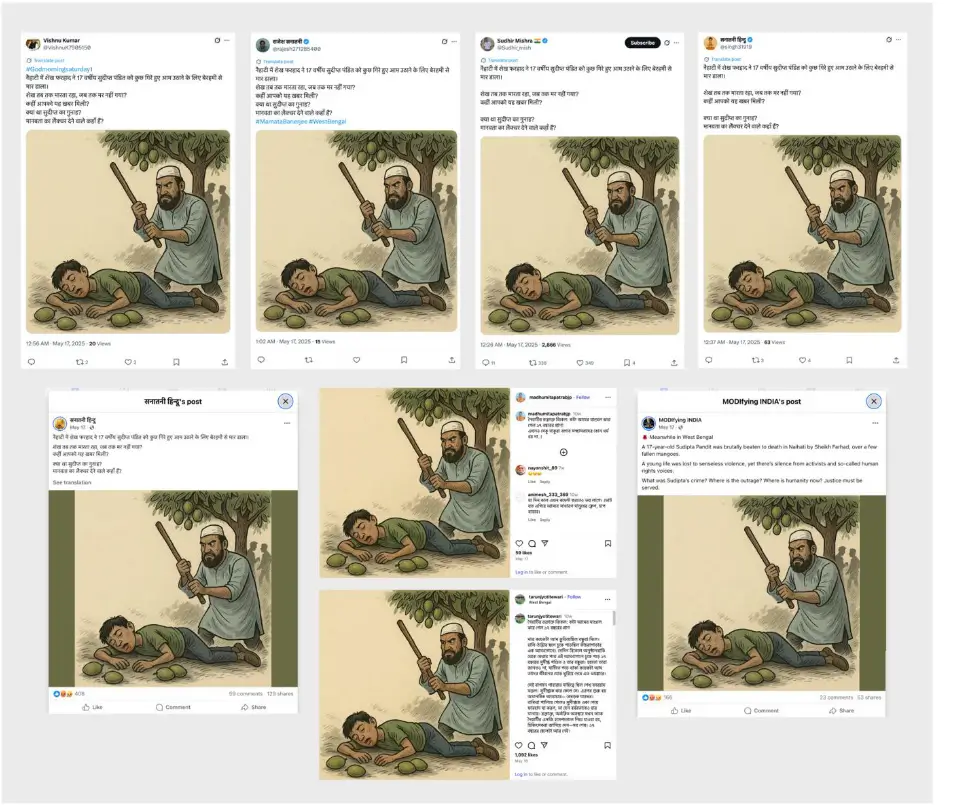
AI images in popular styles like Studio Ghibli are being used to spread hate against Muslims making violent content look funny or harmless and helping it reach more people Source: CSOH Report
What makes these AI-generated images particularly dangerous is how they are being amplified by Hindu nationalist media outlets. The CSOH report found that outlets such as OpIndia, Sudarshan News, Panchjanya, Kreately.in, Organiser Weekly, Satyaagrah, and Zee News were frequently sharing AI-generated images that targeted Muslims. This amplification by established media outlets gives these images a veneer of credibility and helps them reach wider audiences.
Response of social media platforms has been deeply concerning. Of the 187 posts reported for violating community guidelines across X, Facebook, and Instagram, only one was removed on X. This lack of enforcement highlights the challenges of moderating AI-generated content and the urgent need for more effective detection and response mechanisms. As these technologies continue to evolve and become more accessible, the challenge of combating AI-generated hate content will only grow more complex.
Emergence of AI-generated hate content represents a new frontier in the persecution of minorities. By making false narratives more convincing and harder to detect, artificial intelligence is becoming a powerful tool in the hands of those who seek to divide and destroy. The failure of social media platforms to effectively moderate this content poses a grave threat to social harmony and democratic values.
Parallels with Palestine: Indian-Israeli Connection in Persecution
The methods used by Hindu extremists in India bear striking similarities to those employed by Israeli forces against Palestinians. Both systems are built on the idea of a religious or ethnic state that privileges one group over others. Both use security concerns as a pretext for oppression. Both employ similar tactics, including home demolitions, collective punishment, and the restriction of movement. And both operate with a degree of impunity that is enabled by powerful international allies.
The ideological connection between Hindu nationalism and Zionism is not coincidental. Both movements emerged in the early 20th century as responses to perceived threats to their respective religious/ethnic identities. Both see themselves as returning to a homeland that they believe is rightfully theirs. Both view the indigenous population (Muslims in India, Palestinians in Israel/Palestine) as obstacles to the realization of their vision. And both have developed strategies for dealing with these obstacles that are remarkably similar.
Bulldozers & Bombs: How India and Israel Persecute Muslims
🇮🇳 India's Tactics Against Muslims
- Bulldozer demolitions of Muslim homes and businesses
- Collective punishment of entire Muslim communities
- Discriminatory citizenship laws (CAA/NRC)
- Anti-terror laws weaponized against minorities without proof.
- Revocation of special status for Muslim-majority regions
- Settlement of non-Muslims in Muslim-majority areas
- Restrictions on religious practices and institutions
🇮🇱 Israel's Tactics Against Palestinians
- Home demolitions as collective punishment
- Military checkpoints and movement restrictions
- Jewish Nation-State Law privileging Jewish citizens
- Administrative detention without trial
- Annexation of Palestinian territories
- Settlement expansion in occupied territories
- Restrictions on religious freedom at holy sites
Practical cooperation between India and Israel has grown significantly in recent years, particularly under the BJP government. What was once a cautious relationship has blossomed into a strategic partnership, with defense and intelligence cooperation at its core. Israel has become one of India's largest arms suppliers, providing everything from drones to missile defense systems. This military cooperation has been accompanied by intelligence sharing, particularly on counter-terrorism issues.
This cooperation extends beyond the military and intelligence spheres. There is growing evidence that Israeli security agencies are sharing tactics and technologies with their Indian counterparts for controlling minority populations. The surveillance systems used in Kashmir, for example, bear similarities to those used in the occupied Palestinian territories. The "bulldozer justice" employed against Muslims in India mirrors the home demolitions used against Palestinians in the West Bank.
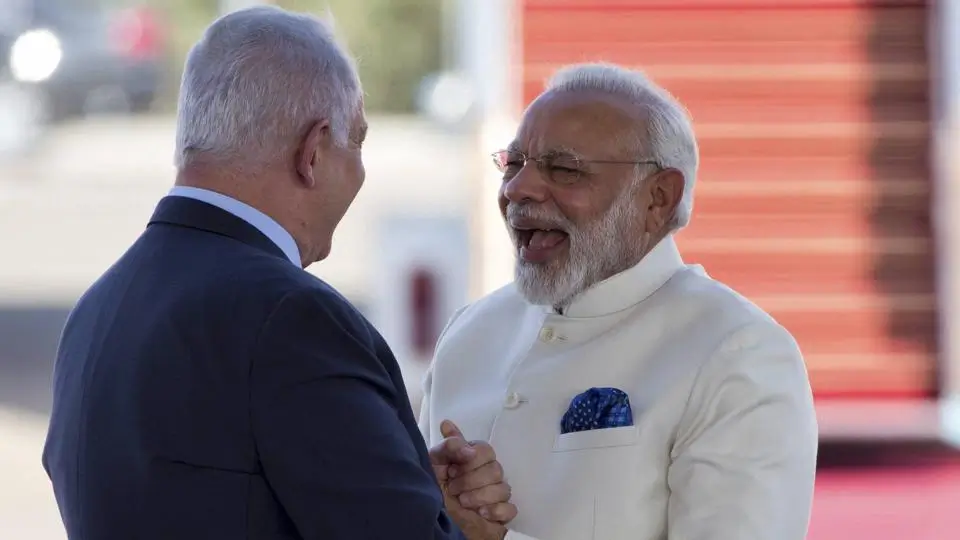
Prime Minister Narendra Modi with former Israeli Prime Minister Benjamin Netanyahu. Strategic partnership between India and Israel has grown significantly in recent years. Source: MEA India
The ideological alignment between Hindu nationalism and Zionism is also reflected in public discourse. BJP leaders and supporters often praise Israel's "strong" stance against terrorism and its willingness to do what is necessary to protect its identity. During the 2021 conflict between Israel and Palestine, many BJP leaders openly supported Israel's actions, despite India's traditional support for the Palestinian cause. This shift in India's foreign policy reflects the growing influence of Hindu nationalist ideology on the country's international relations.
What makes this connection particularly concerning is the normalization of oppression that it represents. Both India and Israel present themselves as democracies while systematically violating the rights of minorities. Both use the language of security and counter-terrorism to justify actions that would be condemned if carried out by other countries. And both rely on powerful international allies (the United States in both cases) to shield them from international criticism and accountability.
Parallels between India and Israel also extend to the international response. Just as the international community has largely failed to hold Israel accountable for its actions against Palestinians, it has been reluctant to criticize India's treatment of Muslims. Economic interests, particularly India's large market and strategic importance in the competition with China, have taken precedence over human rights concerns. This international silence has emboldened both countries to continue their policies of oppression with impunity.
Role of Media: Manufacturing Consent for Hate
Indian Media plays a crucial role in shaping public opinion and influencing political discourse. In India, a significant portion of the media, particularly television news channels and right-wing websites, has become an active participant in the campaign of hate against minorities. Through biased reporting, inflammatory rhetoric, and the amplification of false narratives, these media outlets have helped create an environment where discrimination and violence against Muslims are normalized and even celebrated.
Television news channels, in particular, have become vehicles for spreading hate. Prime-time debates on channels like Republic TV, Times Now, and Aaj Tak often feature panels that are heavily skewed in favor of Hindu nationalist perspectives. Muslim voices are either excluded or marginalized, and when they are included, they are often shouted down and accused of being "anti-national." The language used by anchors and panelists is frequently inflammatory, with Muslims portrayed as a threat to Hindu culture and Indian identity.
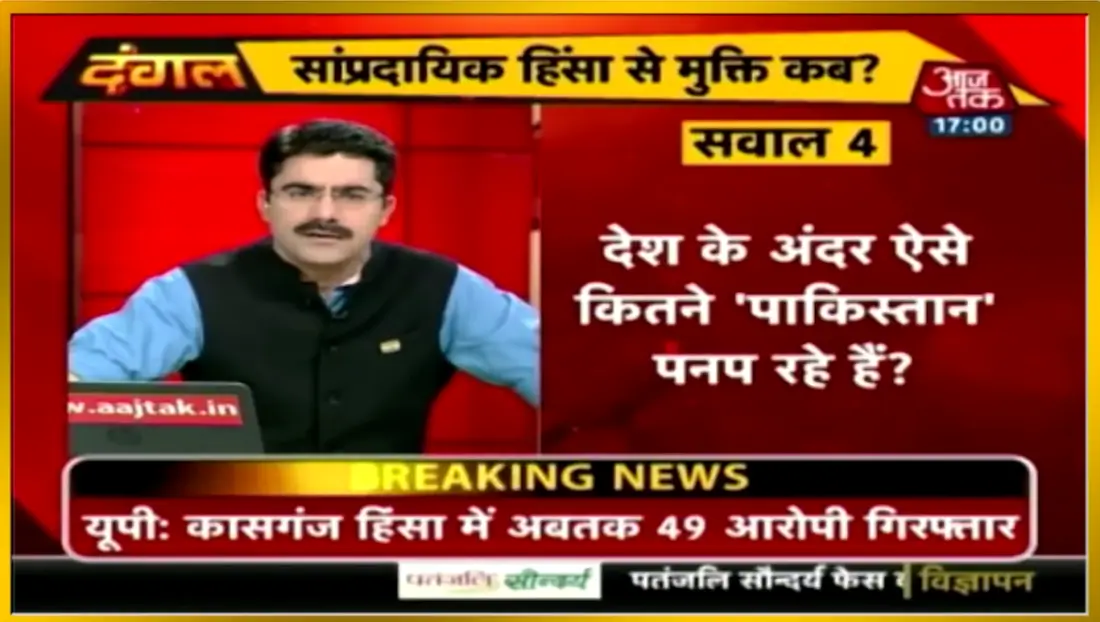
On prime-time TV, anchors frame Muslims as ‘Pakistan within India’ pushing anti-Muslim rhetoric and normalizing hate for millions of viewers. Source: Media Watch
The coverage of communal incidents provides a clear example of this bias. When Hindus are victims of violence, it is presented as an attack on the nation, with extensive coverage and emotional interviews. When Muslims are victims, the coverage is often muted, with focus shifted to the "provocation" that supposedly led to the violence. In some cases, the media even justifies the violence against Muslims, suggesting that it was a natural reaction to their "anti-national" activities.
Social media has played an equally important role in spreading hate. Platforms like Facebook, Twitter, and WhatsApp have been used to disseminate false information and inflammatory content targeting Muslims. According to a report by the Oxford Internet Institute, organized political propaganda operations have reached an estimated 157 million users in India, making it the largest such operation in the world.
BJP and its supporters have been particularly adept at using social media to spread their message. The party's IT cell employs thousands of workers who create and share content supporting the party's narrative and attacking its opponents. This content often includes false claims about Muslims, distorted statistics about population growth, and conspiracy theories about "Love Jihad" and "Land Jihad." The use of memes, videos, and catchy slogans makes this content highly shareable, allowing it to reach millions of users.
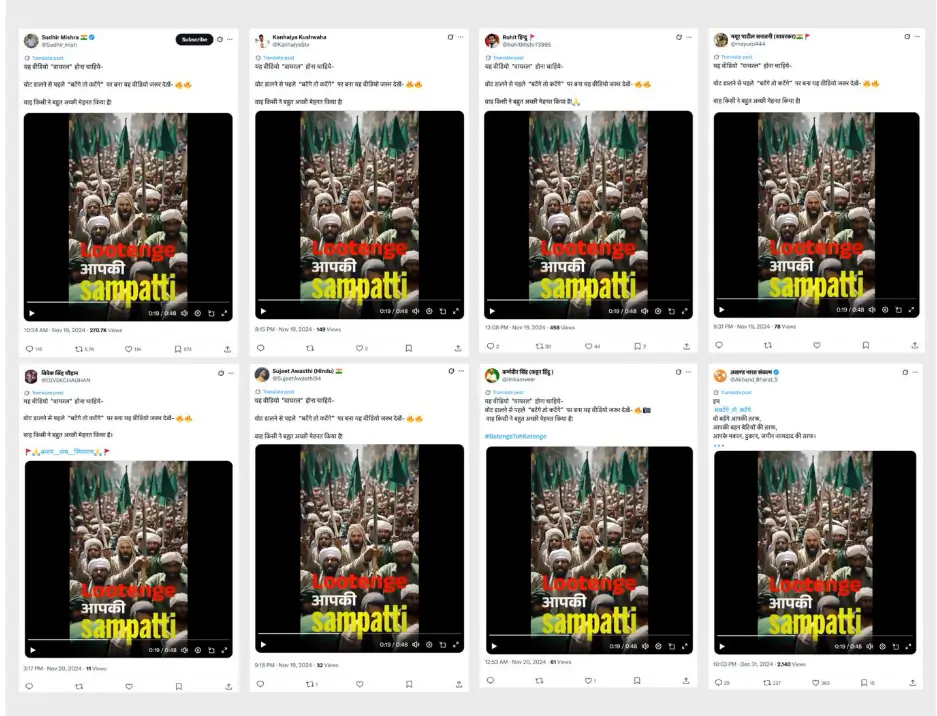
BJP's IT cell employs thousands of workers who create and share content supporting the party's Hindu nationalist narrative. Source: CSOH
Impact of this media ecosystem on public opinion has been profound. According to a survey by Pew Research Center, favorable views of Hindus have increased in India since Modi came to power, while favorable views of Muslims have decreased. The same survey found that a majority of Hindus believe they are discriminated against in India, despite being the majority community and holding most positions of power. This perception of victimhood, fueled by right-wing media, has created a fertile ground for hate and discrimination.
What makes this situation particularly dangerous is the erosion of a shared reality. When different segments of the population consume different media and believe different facts, it becomes difficult to have a meaningful dialogue or find common ground. Muslims in India increasingly feel that they are living in a different country than their Hindu neighbors, with different rights, different opportunities, and different futures. This growing divide threatens the very fabric of Indian society and undermines the possibility of a shared future.
When media outlets abandon their responsibility to report truthfully and instead become mouthpieces for hate, they contribute to the erosion of democratic values. The role of media in a democracy is to hold power to account and give voice to the voiceless, not to amplify hate and division. The failure of much of India's media to fulfill this role represents a betrayal of their public trust.
International Silence
International community's response to the rise of Hindu extremism in India has been characterized by silence and, in some cases, complicity. Despite clear evidence of systematic discrimination and violence against minorities, most countries have been reluctant to criticize India, prioritizing economic and strategic interests over human rights concerns.
The United States, in particular, has been conspicuously silent. As the world's oldest democracy and a self-proclaimed champion of human rights, the U.S. would be expected to speak out against the erosion of democratic values in India. However, strategic considerations, particularly the desire to counter China's influence in Asia, have taken precedence. The U.S.-India strategic partnership, which has grown significantly under both the Trump and Biden administrations, has created an incentive to overlook India's human rights record.
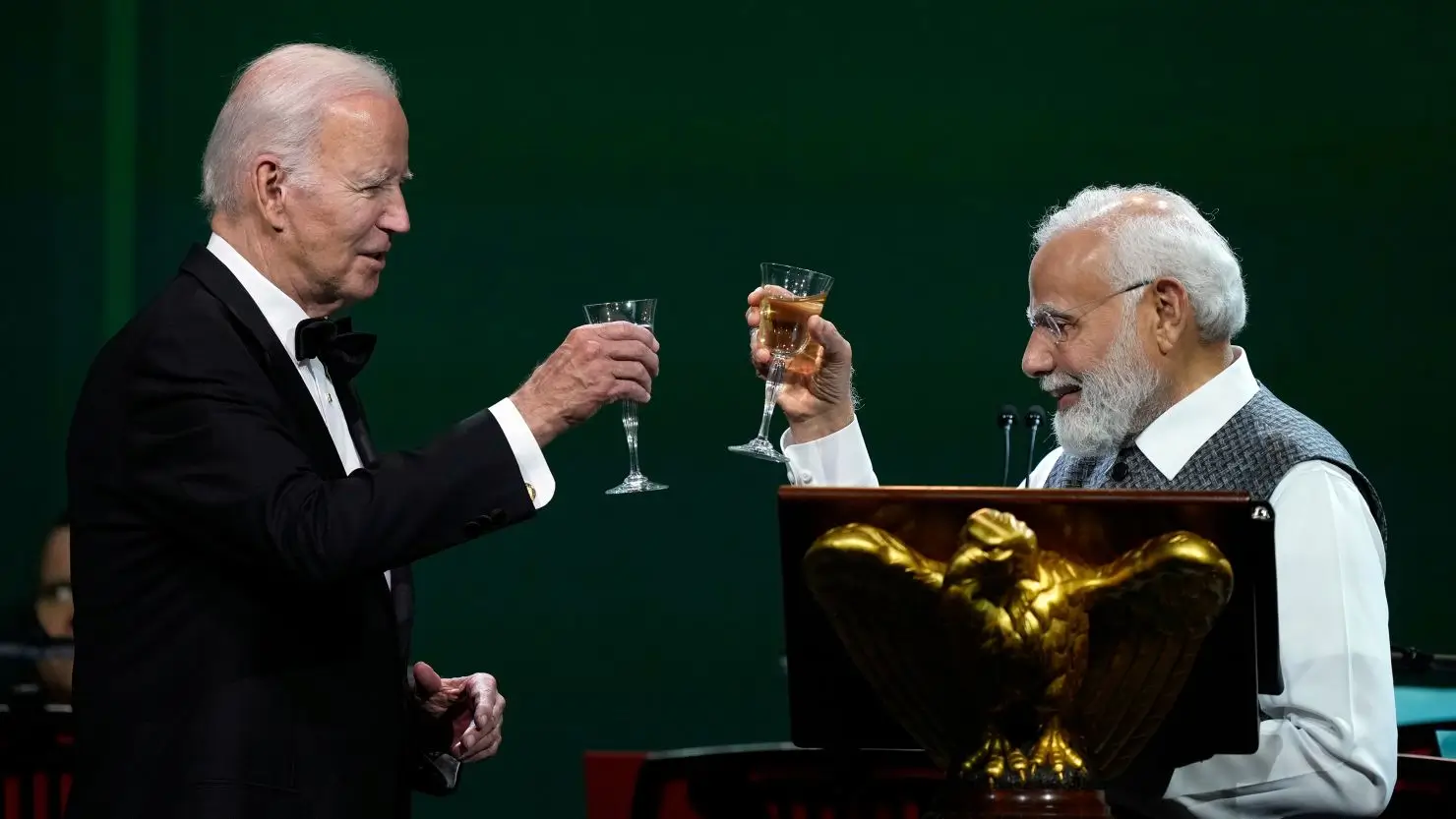
Prime Minister Narendra Modi with U.S. President Joe Biden. Strategic interests have led Western countries to overlook India's human rights record. Source: The White House
European countries have been similarly restrained. While the European Parliament has passed resolutions condemning the CAA and the situation in Kashmir, individual European governments have been careful not to jeopardize their economic relationships with India. India's large market and its role as a counterweight to China make it an attractive partner, and many European countries are unwilling to risk these relationships by raising human rights concerns too forcefully.
Muslim-majority countries have been even more disappointing. Despite their rhetoric of solidarity with Muslims worldwide, most have been silent about the persecution of Muslims in India. Economic considerations, particularly India's large market and its role as a major buyer of oil, have played a significant role in this silence. The Gulf countries, in particular, have deep economic ties with India and are unwilling to jeopardize these relationships by speaking out against the treatment of Muslims.
International human rights community has been more vocal, but with limited impact. Organizations like Human Rights Watch, Amnesty International, and the USCIRF have documented and condemned the deterioration of religious freedom in India. However, their reports are often dismissed by the Indian government as foreign interference, and they have little practical effect on the ground. The Indian government has become increasingly hostile to international scrutiny, restricting access to human rights organizations and even shutting down the Indian office of Amnesty International in 2020.
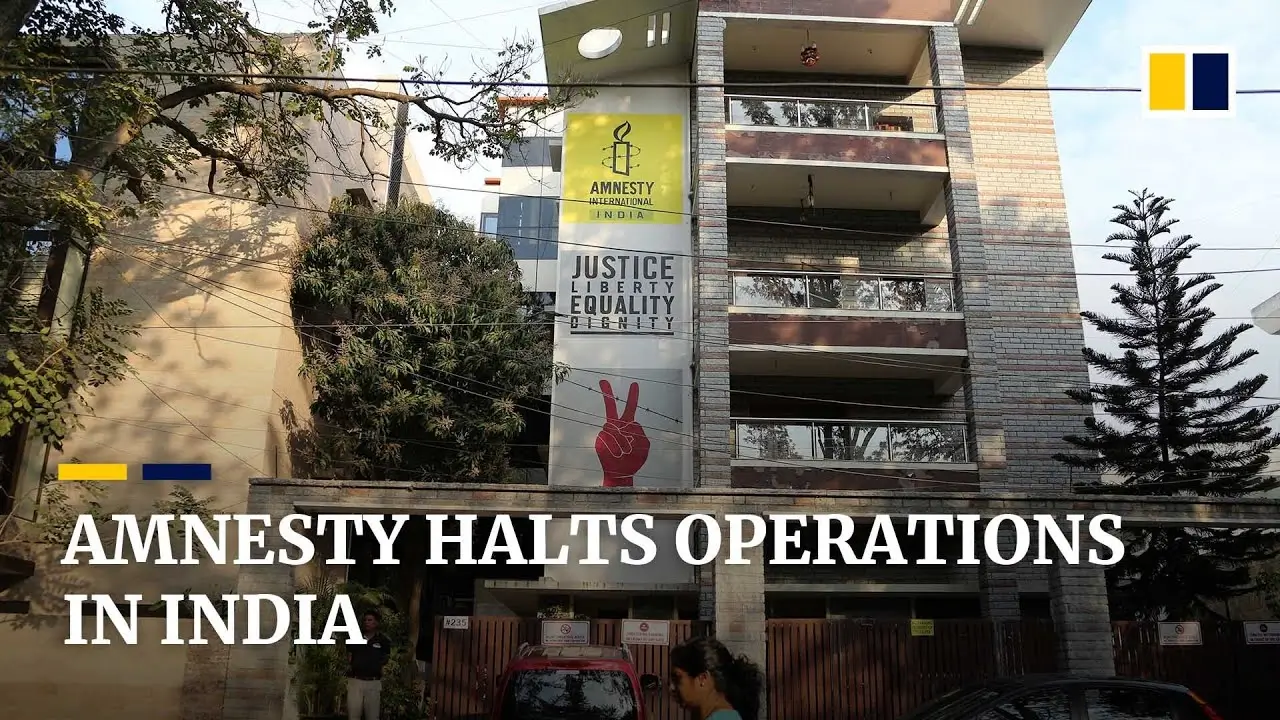
Indian government forced Amnesty International to halt its operations in the country in 2020, part of a broader crackdown on civil society. Source: South China Morning Post
This international silence has created a sense of impunity for the Indian government and Hindu extremist groups. When there are no consequences for violating human rights, there is little incentive to change behavior. This impunity not only emboldens those who commit acts of violence and discrimination but also sends a message to the international community that such actions are acceptable.
The silence of the international community is particularly troubling given the global implications of what is happening in India. As the world's largest democracy, India sets an example for other countries. If democratic institutions can be eroded and minority rights can be violated with impunity in India, it sends a dangerous message to other countries that might be tempted to follow a similar path. The rise of Hindu extremism in India is not just an Indian problem but a threat to democratic values worldwide.
Resistance and Hope: Fighting Back Against Extremism
Despite the grim picture painted above, there are still reasons for hope. Across India, individuals and organizations are working to resist the tide of Hindu extremism and preserve the country's secular traditions. From human rights defenders documenting abuses to artists challenging hate narratives, from lawyers fighting legal battles to ordinary citizens standing up for their neighbors, there is a vibrant resistance movement that refuses to accept the normalization of hate.
One of the most inspiring examples of this resistance is the Shaheen Bagh protest in Delhi, which began in December 2019 and continued for over 100 days. What started as a small sit-in against the CAA grew into a massive movement, with hundreds of women from Muslim and other minority communities gathering day and night to protest the discriminatory law. The protest became a symbol of resistance, inspiring similar protests across the country and drawing international attention to the threat posed by the CAA and NRC.
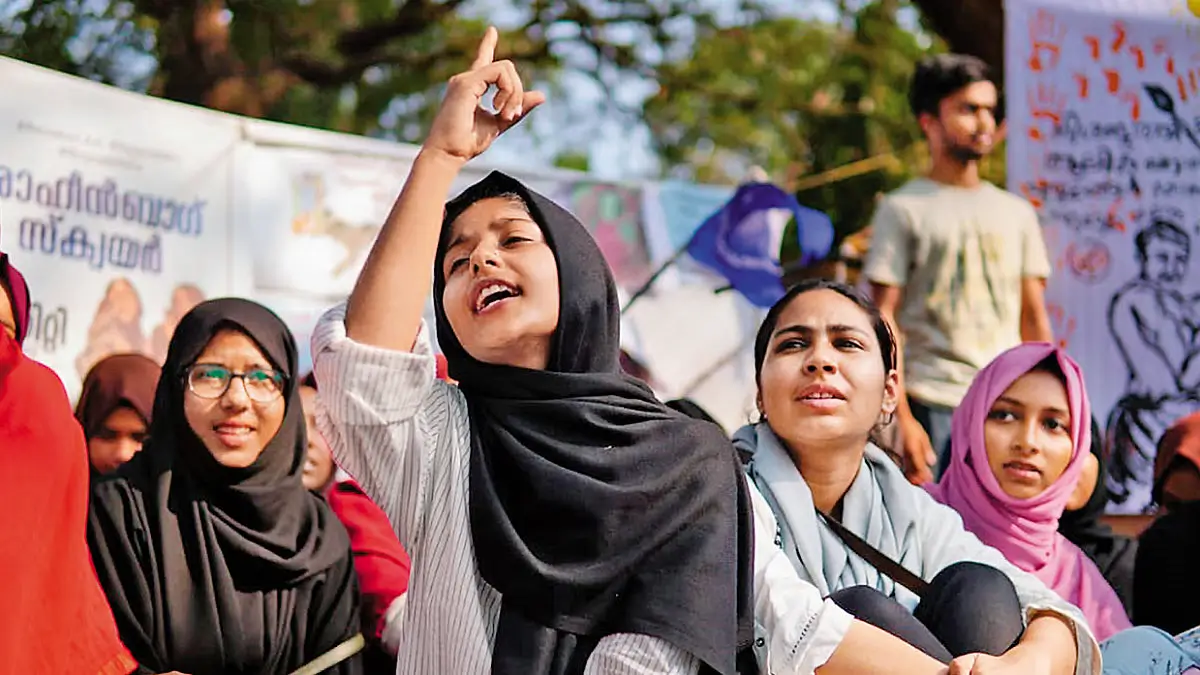
Women from Muslim and other minority communities protest against the CAA at Shaheen Bagh in Delhi. The protest continued for over 100 days. Source: The Guardian
legal community has also played a crucial role in resisting Hindu extremism. Despite the pressures and threats they face, lawyers and judges have continued to fight for justice in individual cases and to challenge discriminatory laws in court. The Supreme Court, while not always consistent, has issued several important rulings protecting civil liberties, including staying the implementation of the NRC and questioning the legality of the CAA. These legal victories, however limited, provide hope that the judiciary can still serve as a check on executive power.
Artists and cultural figures have used their platforms to challenge hate narratives and promote inclusivity. From filmmakers like Anurag Kashyap and Nandita Das, who have made films addressing communalism, to musicians like Indian Ocean and Rabbi Shergill, who have sung about unity in diversity, to writers like Arundhati Roy and Perumal Murugan, who have used their words to defend secular values, the artistic community has been at the forefront of resistance.
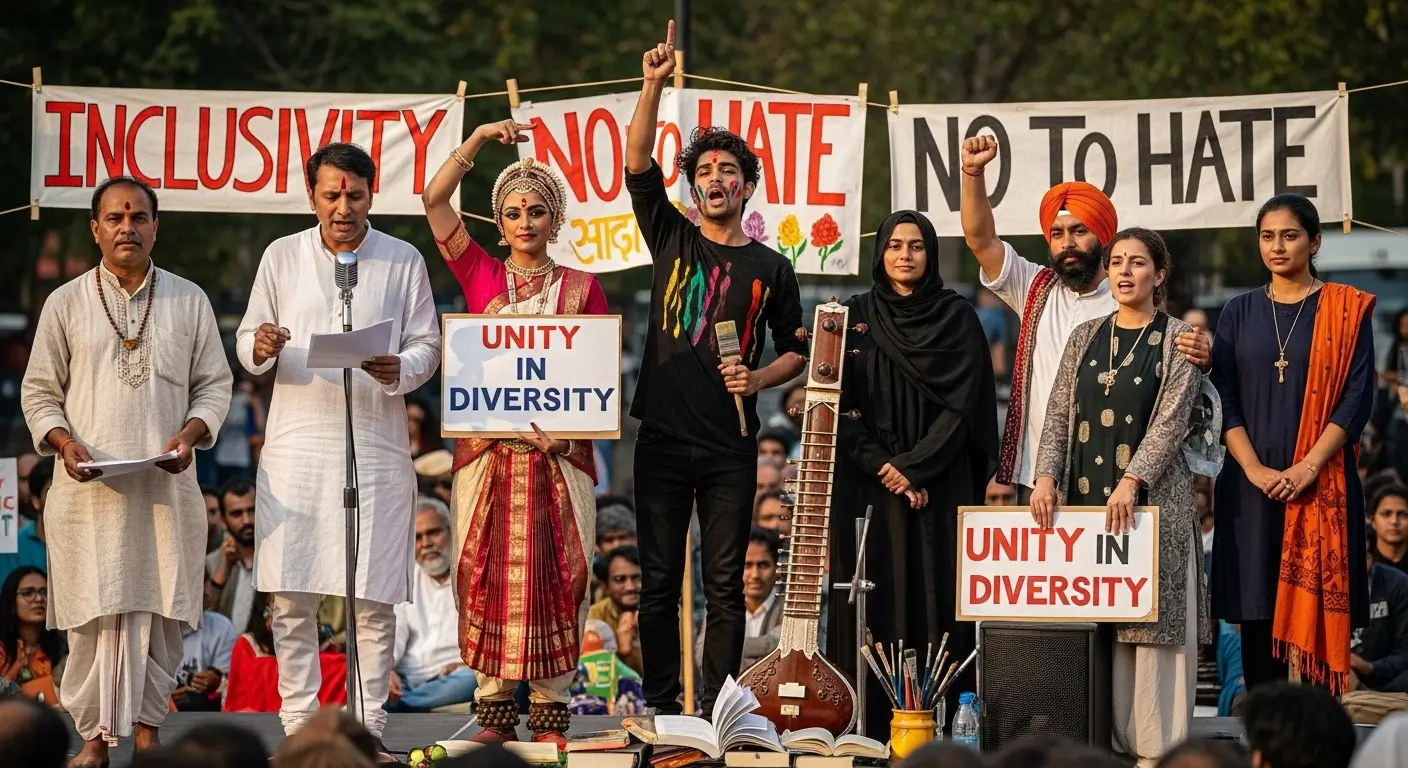
Indian artists and cultural figures have been at the forefront of resistance against Hindu extremism, using their platforms to promote inclusivity.
Civil society organizations have been working tirelessly to document abuses, provide legal assistance to victims, and raise awareness about the threat to India's secular fabric. Groups like the Citizens for Justice and Peace, the Indian Civil Liberties Union, and the Center for the Study of Organized Hate have been instrumental in tracking hate crimes, providing support to victims, and advocating for policy changes. Despite facing harassment and restrictions, these organizations continue their important work.
Perhaps most importantly, there are countless ordinary citizens who are standing up for the values of inclusivity and mutual respect. Hindus who protect their Muslim neighbors during communal violence, teachers who promote critical thinking and secular values in their classrooms, social media users who challenge hate narratives with facts and reason – these unsung heroes are the backbone of the resistance movement. Their courage and commitment give hope that India can still reclaim its democratic and secular values.
The resistance movement is not without its challenges. Activists face harassment, intimidation, and even violence. Civil society organizations are increasingly restricted in their work. The media space for dissenting voices is shrinking. But despite these challenges, the resistance continues to grow and evolve. New forms of protest are emerging, new alliances are being formed, and new strategies are being developed to counter the narrative of hate.
What gives hope for the future is the resilience of India's diverse communities and their commitment to the idea of India as a pluralistic, inclusive democracy. Despite the pressures and threats they face, millions of Indians continue to believe in and work for a country where people of all faiths can live together in peace and mutual respect. This commitment to India's founding values is the strongest weapon against the forces of hate and division.
Future of India's Secular Democracy
India stands at a crossroads. The country's secular, democratic traditions, once a source of pride and inspiration, are under unprecedented threat. Hindu extremism, once confined to the fringes of society, has moved to the center of political power, reshaping institutions and redefining national identity. The consequences for minorities, particularly Muslims, have been devastating, with discrimination, violence, and persecution becoming increasingly normalized.
Parallels with other dark chapters of history, including the ongoing persecution of Palestinians, are too striking to ignore. The use of state power to target a particular community, the dehumanization of that community through propaganda, the erosion of legal protections, the complicity of the international community – these are all familiar patterns that have led to catastrophic consequences in other contexts. India is not yet at that point, but the trajectory is deeply concerning.
Emergence of AI-generated hate content represents a new and dangerous frontier in this campaign of persecution. By making false narratives more convincing and harder to detect, artificial intelligence is becoming a powerful tool in the hands of those who seek to divide and destroy. The failure of social media platforms to effectively moderate this content poses a grave threat to social harmony and democratic values.
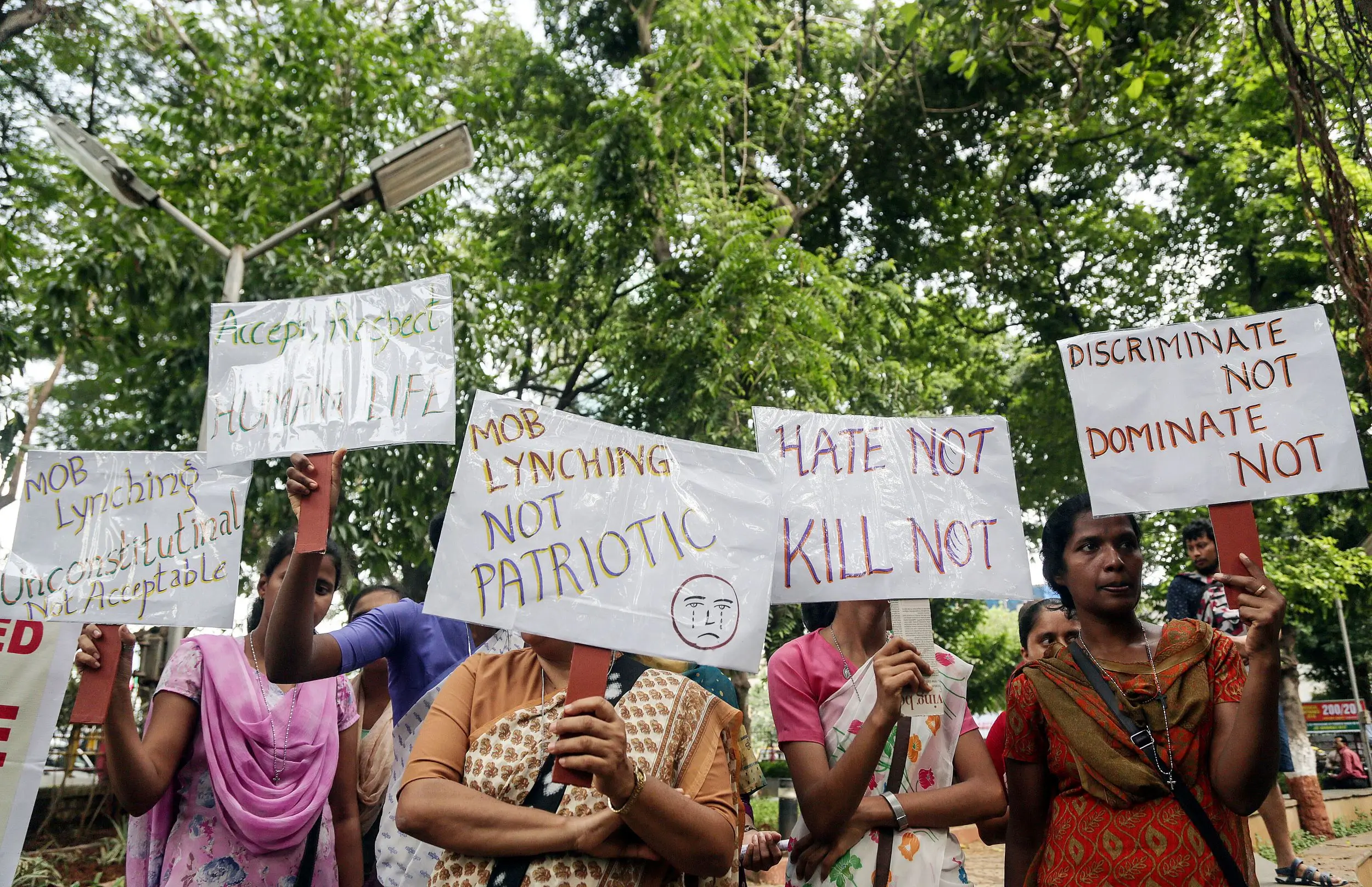
India's strength has always been its diversity. The future of the country depends on preserving this diversity and rejecting the politics of hate. Source: Creative Commons
Future of India's secular democracy will depend on the choices made in the coming years. Will the country continue down the path of majoritarianism and exclusion, or will it reclaim its founding values of inclusivity and pluralism? Will the international community remain silent in the face of growing persecution, or will it speak out and hold India accountable? Will ordinary Indians succumb to the politics of hate, or will they resist and build a more inclusive future?
Stakes could not be higher. If India succumbs to Hindu extremism, it will not only be a tragedy for its own people but also a blow to democratic values worldwide. As the world's largest democracy, India has long been seen as a model for other diverse societies. If this model is replaced by one of majoritarianism and exclusion, it will provide encouragement to authoritarian and nationalist movements elsewhere.
However, if India can resist the tide of extremism and reclaim its secular values, it will send a powerful message to the world. It will show that diversity is not a weakness but a strength, that pluralism is not a threat but a foundation for a vibrant society, and that democracy, even when tested, can endure and flourish. It will provide hope to those fighting for similar values in other parts of the world.
Struggle for India's soul is far from over. The forces of hate are powerful and well-organized, but they are not invincible. The resistance movement, though facing immense challenges, continues to grow and evolve. The international community, though largely silent so far, is beginning to pay attention. The future is uncertain, but it is not yet written.
As we reflect on the state of India's secular democracy, we are reminded of the words of India's first Prime Minister, Jawaharlal Nehru, who said, "The only alternative to coexistence is co-destruction." This is as true today as it was when he first spoke these words. The choice between coexistence and co-destruction is in the hands of the Indian people and the international community. Let us hope they choose wisely.
Story of India is not just the story of a nation; it is a test case for whether diverse societies can thrive in an increasingly polarized world. What happens in India will have implications far beyond its borders. The world is watching, and history will judge not just the perpetrators of hate but also those who remained silent in the face of it.
All rights reserved. This article is based on the report "AI-Generated Imagery and the New Frontier of Islamophobia in India" published by the Center for the Study of Organized Hate (CSOH).




